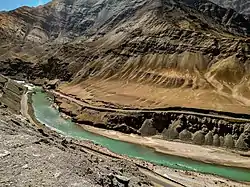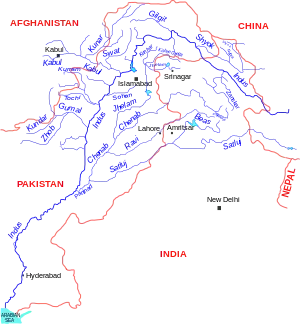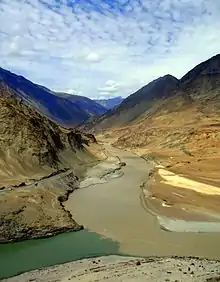| Zanskar River | |
|---|---|
 Zanskar River | |
 Map of the Indus River System - the Zanskar is a tributary of the Indus | |
 Location of mouth | |
| Location | |
| Country | India |
| State | Ladakh |
| Physical characteristics | |
| Mouth | |
• coordinates | 33°46′19″N 76°50′43″E / 33.7719174°N 76.8453493°E |
| Basin features | |
| River system | Indus River |

The Zanskar River is the first major tributary of the Indus River, equal or greater in volume than the main river,[1] which flows entirely within Ladakh, India. It originates northeast of the Great Himalayan range and drains both the Himalayas and the Zanskar Range within the region of Zanskar. It flows northeast to join the Indus River near Nimo.
Etymology
Zanskar (Zangs-kar) means "white copper" or brass.[2]
Course
In its upper reaches, the Zanskar has two main branches. First of these, the Doda, has its source near the Pensi-la 4,400 m (14,400 ft) mountain-pass and flows south-eastwards along the main Zanskar valley leading towards Padum, the capital of Zanskar. The second branch is formed by two main tributaries known as Kargyag river, with its source near the Shingo La 5,091 m (16,703 ft), and Tsarap river, with its source near the Baralacha-La. These two rivers unite below the village of Purne to form the Lungnak river (also known as the Lingti or Tsarap). The Lungnak river then flows north-westwards along a narrow gorge towards Zanskar's central valley (known locally as gzhung khor), where it unites with the Doda river to form the main Zanskar river. This river then takes a north-eastern course through the dramatic Zanskar Gorge until it joins the Indus near "Nimmu" in Ladakh.[3]
Tourism
Area has homestays, Buddhist monastery and valley tourism.
Lower (northern) sections of that gorge are popular in summer with tourists making rafting trips, typically from Chiling to Nimmu. In winter when the road to Zanskar is closed by snow on the high passes, the only overland route to Padum is by walking along the frozen river, a multi-day hike that is now sold as an adventure activity called the Chadar Trek ('ice sheet').[4] This trek will eventually be rendered obsolete once the road from Chiling to Padum is completed.[5]
See also
References
- ↑ Cunningham, Ladak (1854), p. 88.
- ↑ Cunningham, Ladak (1854), p. 22.
- ↑ Phartiyal, Binita; Singh, Randheer; Nag, Debarati (2017), "Trans- and Tethyan Himalayan Rivers: In Reference to Ladakh and Lahaul-Spiti, NW Himalaya", in Dhruv Sen Singh (ed.), The Indian Rivers: Scientific and Socio-economic Aspects, Springer, p. 375, ISBN 978-981-10-2984-4
- ↑ Sumitran, Neha (1 April 2014). "On the Mighty Chadar, Everything Freezes but Tears". National Geographic Traveller India. Retrieved 2 February 2020.
- ↑ Trekking in the Indian Himalaya by Garry Weare, Lonely Planet guide, page 71
Bibliography
- Cunningham, Alexander (1854), Ladak: Physical, Statistical, Historical, London: Wm. H. Allen and Co – via archive.org
- Drew, Frederic (1875), The Jummoo and Kashmir Territories: A Geographical Account, E. Stanford – via archive.org
- Strachey, Henry (1854), Physical Geography of Western Tibet, London: William Clows and Sons – via archive.org
External links
- Zanskar River basin, OpenStreetMap, retrieved 18 December 2020.
- Doda River, OpenStreetMap, retrieved 18 December 2020.
- Lunknak River, OpenStreetMap, retrieved 18 December 2020.
- Tsarap River, OpenStreetMap, retrieved 18 December 2020.